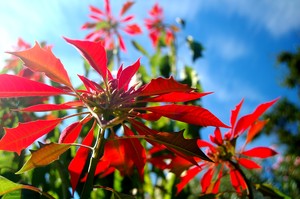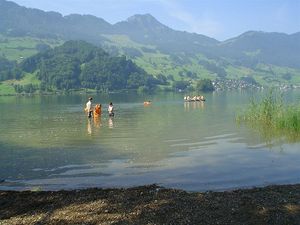Poinsettias grace the homes of millions of American’s each December bringing bright Christmas cheer – but as soon as the holidays are over, most of them are discarded. I never knew that there was any other choice. My mother was an avid gardener, yet she cast hers away so I assumed that their lives were over once the season passed.
I found out differently when I visited my college professor. The gigantic tree in his window immediately commanded my attention. Upon inquiring, I discovered that it was an ordinary poinsettia. Fascinated, I vowed to grow one of my own – “someday.” As you may have guessed, it took me a “few” years before I actually tried it on my own.
Today, my three-year old poinsettia is about 2 feet tall and has developed the characteristic woody branches. Last year it bloomed from November to January. This year it has not bloomed – not because of any fault with the plant, but because I neglected to give it proper care. You see, I left it outside a bit too long and missed the opportunity to force it into bloom.
Keeping your poinsettia alive for years is relatively easy, but does require consistent care.
Winter Care
Cut the plant back once the “flowers” fade and leaves begin to drop – sometime in January or February. Cut each flowering branch back to 4 to 6 inches in height. This forces new growth and creates a bushy plant.
Water thoroughly until water runs freely through the bottom of the pot and place it on a sunny windowsill where temperatures remain between 60 and 70 degrees F. Water when the soil feels dry to the touch. Poinsettias begin to drop leaves quickly if the soil remains dry.
Fertilize with water-soluble fertilizer once or twice a month from spring until fall. Repot your poinsettia in the spring to give roots room to grow. I use a mixture of one part peat moss, one part potting soil and one part perlite for my poinsettia.
Summering poinsettias outside
Place your poinsettia outside in a sheltered location once the danger of frost has passed in your area and temperatures remain above 50 degree F at night. Gradually move the plant to full sun.
Check the soil often and water when it feels dry. During the height of summer, my plant requires daily watering, but watering needs depend of the size of the plant, the container it is grown in and the weather.
Move your poinsettia inside in the fall when nighttime temperatures begin to dip into the 50’s. I made the error of leaving mine outside a bit too long this year which caused severe leaf drop when I moved it inside. Fortunately, poinsettias are forgiving. Mine is now in full foliage, again – but I wasn’t able to force it into bloom as the foliage was still too small for that.
Forcing blooming
To force your poinsettia to bloom, place it in full darkness for 12 hours a day, beginning in October. Remember even stray light from a nightlight or outside sources will prevent blooming. Many prefer to set the plant in a closet at night and return it to sunlight during the day. Placing a cardboard box over the plant works, as long as it blocks all light.
Move the poinsettia to the desired location and cease fertilizing when the bracts begin to show signs of color. The plant no loner needs to darkness to produce the characteristic Christmas colors.
I’m considering forcing mine into bloom sometime in January or February to add a bit of color to the home. Although I missed the opportunity to enjoy my poinsettia this Christmas, I’m thinking it will be quite the conversation piece for Valentine’s Day.
Other Work by this author:
Tips for Caring for Fresh Holiday Flowers
Five Simple Christmas Floral Arrangements You Can Make Yourself
Winter Houseplant Care



